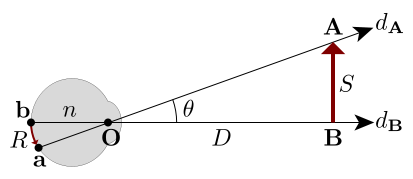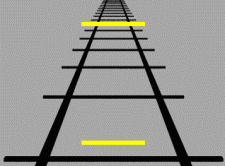Why do the images produced by two opposing flat mirrors appear to be progressively smaller?
1 Answer
We know that a plane mirror forms an image which is virtual, of the same size of the object and situated at the same distance behind the mirror as the object is in front of it.
Multiple images of the same object are formed by two opposing flat mirrors because image formed in one mirror serves as object for the other mirror.
These images appear to be progressively smaller due to distance of each from the eye or due to our perception.
The perceived size of objects seen by eye and analyzed by brain depends on a number of factors.
(a). The most important of these is the visual angle

As shown in the figure above,
Where
All other things being equal, the object that subtends the larger visual angle will appear larger.
(b). Another factor effecting perceived size is size constancy. This results due to objects of known size tending to appear constant in size regardless of small change in the distance from eye. However, If the distance is large even known objects will appear smaller.
(c). Another factor that can influence perceived size is perspective. If objects of same size are placed in an environment where there are strong perspective cues, these objects can appear larger at greater distances.
There are many illusions which have been described.
A. Ponzo illusion

Both of the horizontal yellow lines are the same length.
B. Ebbinghaus illusion.
The two orange circles are of same size. The one on the left is perceived smaller.
C. Demonstration invented by Adelbert Ames, Ames distorted room.
